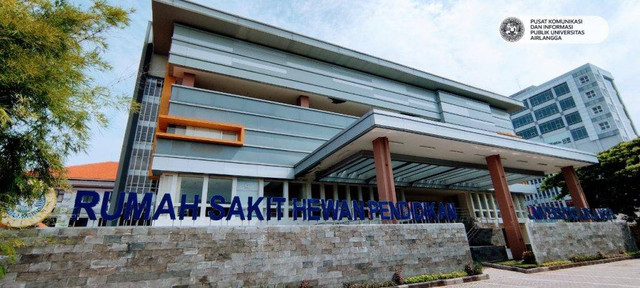Tentang KamiPedoman Media SiberKetentuan & Kebijakan PrivasiPanduan KomunitasPeringkat PenulisCara Menulis di kumparanInformasi Kerja SamaBantuanIklanKarir
2025 © PT Dynamo Media Network
Version 1.103.0
Konten dari Pengguna
Communication in the Animal Hospital: Through the Eyes of an Aspiring Veterinary
29 Desember 2024 15:31 WIB
·
waktu baca 4 menitTulisan dari Syahmi Azri tidak mewakili pandangan dari redaksi kumparan

ADVERTISEMENT
On Friday November 8 2024 I visited Rumah Sakit Haiwan Airlangga (Airlangga Animal Hospital) as part of a field trip in order to observe communication in a healthcare setting. The aim was to investigate how effective communication is used therapeutically in interactions between staff, clients and patients. Throughout the visit I closely monitored both verbal and non-verbal exchanges between receptionists veterinarians and interns. This experience provided valuable insight into how clear and empathetic communication can significantly enhance healthcare delivery.
ADVERTISEMENT
At first I observed a steady stream of visitors, primarily pet owners whose pets frequently appeared anxious about their pet’s well-being. My first interaction was with the receptionists who welcomed each visitor warmly with smiles and polite words. They maintained direct eye contact and displayed relaxed body language which helped put visitors at ease with their relaxed appearance. The study showed that nonverbal cues like smiling and eye contact can create a calming effect before much is said on a speech.
In the waiting area the reception staff juggled multiple tasks while remaining polite and approachable. They gave clear and straightforward instructions, ensuring their language was accessible to visitors who might not be familiar with medical terms. Their friendly tone helped alleviate some of the stress the pet owners were feeling. This highlighted how the communication between front-line staff can shape a visitor’s overall experience in a healthcare facility.
ADVERTISEMENT
Next the vets in the examination rooms conducted initial checks in the examination rooms. They skillfully combined verbal and non-verbal cues to help pets reassure pet owners. For example one veterinarian spoke softly, maintained eye contact and nodded while addressing concerns. This calm, sympathetic approach seemed to comfort the owners.
When explaining medical problems the veterinarians avoided jargon trying instead to use simple, easy-to-understand language. They used hand gestures to clarify their points, such as indicating parts of animal body and making it easier for owners to follow along. This adaptability underscored the importance of clear communication in healthcare especially when dealing with individuals unfamiliar with medical concepts.
One memorable interaction was with a veterinarian explaining to a worried pet owner a surgical procedure. She patiently detailed the process, recovery expectations and aftercare requirements for customers. When owner had numerous questions she repeats herself willingly to ensure everything was understood. This encounter emphasized the importance of active listening and tailoring responses to meet individual needs ensuring clients feel heard and reassured.
ADVERTISEMENT
I also observed the communication dynamic among employees which varied depending on the context. In the Operation Theater conversations were focused concise and focused reflecting the need for quick and precise communication in high-pressure situations. Despite the brevity the exchanges remained respectful and collaborative showcasing professionalism even in brief interactions.
In the intensive care unit communications carried on an instructional tone among senior staff and interns. Veterinarians provided detailed step-by-step explanations and encouraged interns to ask questions. I watched one vet guide an intern in handling an injured cat and explained each step in detail throughout the procedure. This patient and open communication fosters a positive learning environment allowing interns to gain confidence and knowledge.
ADVERTISEMENT
Non-verbal communication played a significant role in interactions with animals and humans. In the Rehabilitation Room a veterinary therapist used slow, deliberate movements and a soothing voice during a hydrotherapy session with a dog in the These gentle non-verbal cues helped the dog feel more at ease and showed the importance of trust-building through calm and careful handling.
Teamwork was also enhanced by non-verbal cues among staff. Quick glances and subtle nods facilitated seamless coordination without disrupting ongoing processes. It was impressive to see how well the staff understood one another’s working styles, enabling efficient collaboration with minimal verbal communication.
This visit underscored the therapeutic value of effective communication in healthcare. The combination of verbal and nonverbal strategies has created a supportive and reassuring environment for both clients and patients. Observing how staff adjusted their communication styles based on the needs of different individuals highlighted the significance of empathy and clarity in building trust and satisfaction.
ADVERTISEMENT
However, I noticed an area for improvement: the registration process at the reception. The reliance on paperwork caused occasional delays. Implementing a digital system could streamline this process, allowing staff to focus on engaging with visitors and reducing wait times. This small adjustment could enhance the overall experience for everyone.
My visit to Rumah Sakit Haiwan Airlangga demonstrated the profound impact of effective communication in healthcare environments. From receptionists to veterinarians and interns every professional contributed to creating a welcoming and therapeutic environment. This experience reinforced that successful communication is not just the exchange of information—it is about
making meaningful connections that leave people feeling valued and cared for.
ADVERTISEMENT

